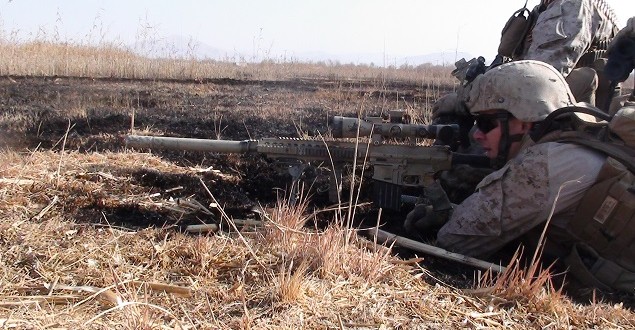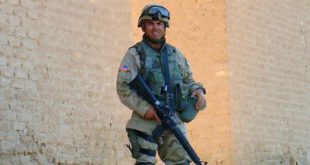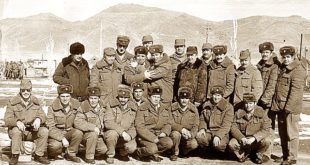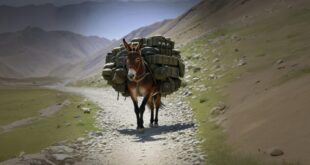By Bing West
From the December 2014 issue of SOF
 The Setting
The Setting
Sangin was the most violent district in Afghanistan, a remote farmland in southern Helmand Province at the far south of the country. Beginning in 2006, British forces defended the government compound next to the district market, while the Taliban controlled the outlying fields where poppy was grown in abundance. To profit from the opium export, the Taliban planted thousands of land mines around the British outposts and attacked every patrol that sallied forth. Afghan officials never ventured beyond the market. Helicopters provided resupply only at night. Daylight flying was too dangerous. By 2010, Sangin was isolated and under siege.
Then the U.S. Marines were sent in.
“What does Sangin mean?” four-star Marine General John Kelly said when it was over. They sent us there to fight—so we fought.”
The British Effort
In 2001, America and its allies invaded Afghanistan in response to the destruction of the Twin Towers. However, the invasion was botched, allowing the Al-Qaeda terrorists to escape into Pakistan, along with the Taliban Islamists who had harbored them. America then stayed to build a democratic nation. As President George W. Bush explained, nation building was America’s “moral obligation.”
The U.S. commander, Gen. Tommy Franks, claimed that the Taliban had been “squeezed into extinction.” By 2005, however, the Taliban had surged back. Helmand Province in the south was in danger of being completely overrun. Sharing an open border with Pakistan, Helmand accounted for 70 percent of the world’s opium and heroin supply. The New York Times reported $155 million in drug money went into Taliban coffers.
Helmand had to be brought under government control. The tribes in the province were Pashtuns, as were the Taliban. The few Afghan soldiers were northern Tajiks, who spoke a different language and hovered inside a few bases. In 2006, the British sent in a 5,000-man brigade. But the province, 300 miles in length and home to a million farmers, was half the size of England, far beyond the control of 5,000 soldiers. One British general likened the effort to “mowing the lawn,” with the Taliban returning as soon as the British departed an area.
At the northern end of the province lay Sangin, a 200-square-mile rectangle of farmlands bordered on the west by the Helmand River and on the east by a rutted road called Route 611. Beyond those boundaries lay miles of uninhabitable desert. Near and around the district market lived about 15,000 Pashtuns in a maze of one-story, cinder-block and mud houses and slopes bare of shade trees. To the north, several thousand farmers lived in compounds in the middle of vast fields of corn and poppy.
 Next to the market, the British established a forward operating base (FOB) called FOB Jackson that was under constant siege. The Brits decided that trying to control the outlying farming areas was not worth the cost in casualties. By staying inside their forts, however, they were subjected to routine attacks.
Next to the market, the British established a forward operating base (FOB) called FOB Jackson that was under constant siege. The Brits decided that trying to control the outlying farming areas was not worth the cost in casualties. By staying inside their forts, however, they were subjected to routine attacks.
The British opened schools and built up the market. Dozens of stores with gaily colored goods lined the “Avenue of Hope,” a half-mile-long strip of Route 611 next to FOB Jackson. Despite the constant attacks, a British general explained, “The central theme of the counterinsurgency, winning the hearts and minds, was still core to our plans.”
But no Afghan official wanted to serve in the district and the few police ventured beyond the market. Riding in motorbikes and pickup trucks, the Taliban drove around the outlying farmlands in teams of 5–20, paid and supplied by patronage networks called mahaz. Operations were directed by military commissioners, or nizami, who reported to the main headquarters in Quetta, Pakistan, 80 miles to the east. The Taliban in Pakistan provided hardened Punjabi fighters, some not even speaking Pashto, to train the locals in tactics and bomb making.
In Sangin, the Taliban drew most of its local fighters from the Ishaqzai tribe. The Taliban went from farm to farm, saying, “You are not Muslim unless you support jihad. Send at least one of your sons to fight with us.” Let unsaid was that when the Taliban seized power, the cooperative tribes would be rewarded with a larger share of the poppy trade.
At the end of his tour, one British platoon leader wrote, “Sangin was no safer than when we found it. In fact, it was more dangerous and getting even more so.” A soldier described his outpost as “ringed in.” The British troops called the district “Sangingrad,” a reference to the World War II siege of Stalingrad. Finally, the Afghan provincial governor asked the British to “stop referring to Sangin as a district, when all you occupy is a base.”
 Marine-istan
Marine-istan
With the situation out of control in Sangin and across Helmand Province, in mid-2009 President Barack Obama authorized the U.S. Marines to move in. The Marines were the vanguard in a surge of 30,000 American troops that the president said would last only for 18 months. From the first day of their deployment, the Marines knew they would be leaving based on a calendar rather than victory.
One sweltering night in July of 2009, I was sitting with a few newly arrived Marines in an outpost in Helmand when a helicopter landed. A wiry Marine with close-cropped gray hair hopped out and called us together.
“Here’s the deal,” Brig. Gen. Larry Nicholson rasped, the red battle scar on his neck glistening in the candlelight. “We’re here to take their home turf from the Taliban. I want you to patrol until your asses fall off. Run every fucker who shoots at you out of the district.” I had first met Nicholson in 2006, when he was a colonel fighting in Fallujah. Back then, when Nicholson met with the city council, he promised fair treatment. “I have pulled Marines who do not act properly out of the city,” he said. “They had betrayed my trust; I lost confidence in them.”
At the same time, he threw up a dirt berm around the city, erected concrete walls sealing off each neighborhood and placed Marines on every street corner. Once the insurgents were killed in one neighborhood, he moved on to the next. He ground down the enemy.
Marines fight the way the Chicago Bears play football; they line up and run over the opposition. Nicholson’s commander, Maj. Gen. James Mattis, had set the tone in Iraq, telling defiant sheiks, “I’m pleading with you, with tears in my eyes: If you fuck with me, I’ll kill you all.”
Now in Afghanistan, Nicholson issued the same clear order every corporal could understand. The mission: drive the enemy out of Helmand by walking every foot of farmland. Nicholson spread his forces out along the Helmand River where the people lived, with orders to clear their way south. Sangin, in the remote north, would wait until last.
At the higher levels, though, a more sophisticated, squishy, philosophy prevailed. A few weeks before the Marines arrived, Adm. Mike Mullen, the Chairman of the Joint Chiefs of Staff, had announced that America, after eight years of fighting, finally had “the right strategy” for Afghanistan. Mullen explained that the U.S. troops were building a nation. As a model, he praised the book Three Cups of Tea, which espoused village-level projects, and spent a day visiting a girls’ school in Afghanistan. America’s top military leader had replaced war with social evangelism. The Muslim tribes would be converted by the secular gods of liberalism—schools, electricity and other benefits bestowed from America via Kabul. “We can’t,” Mullen asserted, “kill our way to victory.” Empathy was to be the path forward.
 Confusion about the Marines’ role deepened a few months after they arrived in Helmand. The White House changed the mission from “defeat” to “diminish” the Taliban. Asked to explain the meaning of “diminish,” the Chairman of the Joint Chiefs was stumped.
Confusion about the Marines’ role deepened a few months after they arrived in Helmand. The White House changed the mission from “defeat” to “diminish” the Taliban. Asked to explain the meaning of “diminish,” the Chairman of the Joint Chiefs was stumped.
“I urge our troops,” he said, “to think carefully about how they will accomplish the mission they have been assigned.”
Was the mission of the Marine Corps to act as a Peace Corps? Down in Helmand, 500 miles physically and psychologically removed from Kabul, Nicholson walked a fine line. The Marine command did not know they were going to war under such a cloud of bureaucratic confusion. Their focus was upon defeating the enemy.
The Marines are a small, tight outfit. Think of a golf ball; inside a hard shell are hundreds of tightly coiled elastics. An order relayed down the chain of command is like dropping that ball down a flight of stairs. From top to bottom, the golf ball bounces the same way with the same energy.
Tensions between the Marines and the top command grew. In February of 2010, the Marines pushed the Taliban out of one of their strongholds called Marjah. Army Gen. Stanley McChrystal, the top commander in Kabul, then announced, “We’ve got a government in a box, ready to roll in.”
Two months and two governments in boxes later, the Marines were still struggling, without any competent Afghan officials, to flush out the secret Taliban cells controlling the villagers. McChrystal responded by flying down to Marjah to berate the Marine battalion commander for being too slow. In reaction, the Marines silently assessed the top command in Kabul as disconnected from the realities of tribal loyalties and Afghan government incompetence.
When Nicholson finished his tour in mid-2010, the Marines had gained control of the southern portion of Helmand. Insisting that high-level staffs were giving them orders without understanding the battlefield, the Marine command successfully lobbied to take charge of most of Helmand, replacing the overstretched British. Free to design their own approach, the Marines cut down their task to one essential: fighting the enemy.
“We [Marines] can’t fix the economy,” Marine four-star Gen. James Conway said. “We can’t fix the government. What we can do is affect the security.”
In Marine parlance, security meant seeking out and destroying the enemy. But Secretary of Defense Robert Gates did not trust the warfighting judgment of Marines. In his memoir, he wrote that his “biggest mistake” was not swiftly resolving high-level command issues.
 “He [Conway] insisted all Marines deploy to a single area of responsibility,” Gates wrote, “with Marine air cover and logistics. Only Helmand fitted Conway’s conditions. . . . The Marine higher leadership put their own parochial service concerns above the requirements of the overall Afghan mission.”
“He [Conway] insisted all Marines deploy to a single area of responsibility,” Gates wrote, “with Marine air cover and logistics. Only Helmand fitted Conway’s conditions. . . . The Marine higher leadership put their own parochial service concerns above the requirements of the overall Afghan mission.”
Karl Eikenberry, the American ambassador in Kabul, agreed, testily observing that, in addition to dealing with 32 nations, he now had to cope with “Marine-istan,” yet another tribe operating by its own rules. To many observers, Marines had the subtlety of a steamroller, rolling forward at its own inexorable pace and going wherever it chose to go.
The Road to Sangin
The Marines chose to go to Sangin. After 18 months of clearing southern Helmand, the Marines turned north. The British, having lost a hundred soldiers there and having made scant headway in four years, readily agreed to hand over the effort.
Gaining control of Sangin did have a wisp of strategic rationale. Route 611 wound 60 kilometers north from the center of Helmand to Sangin. From there, the road ran another 20 kilometers before ending at Kajacki Dam. There, two hydroelectric turbines provided a trickle of power to a million Pashtuns. Since 2001, the Western coalition had tried to open Route 611 in order to transport a third turbine up to the dam. That increase in power generation would symbolize development in southern Afghanistan, but Taliban control of Sangin prevented any such demonstrations of progress.
Security in northern Helmand, to include Sangin, was the responsibility of the 2d Marine Regiment. By dint of personality, the commander, Col. Paul Kennedy, shaped the command climate— the rituals, task priorities, and combat behavior of 6,000 Marines. He talked in a fast Boston accent, assuming his listeners had processed what he had just said while his mind hurried on to the next thought.
Kennedy sopped up tactics. With a grunt’s eye for terrain, he viewed vistas and landscapes as angles and planes for bullets. No setting was pastoral, and no scenery was soothing. When he looked at a map, he saw geometries of fire; when he walked across a field, he thought in terms of grazing fire; when he visited farms, he wondered where arms caches were hidden.
In 2004, Kennedy had led an 800-man battalion into the Iraqi city of Ramadi. He wanted to be friendly. The plan had been to wear no armor, walk the neighborhoods, fund projects, train the police and leave. The insurgents mocked the Marines as shotak, a soft, sugary cake, and launched a full-scale assault to seize the city. The battle raged for a week. When the hospital and morgue overflowed, the Marines piled the bodies of rebels and former Iraqi soldiers on street corners, leaving burial to the residents.
After the battle, Kennedy wrote to the families in the States, “Previous to yesterday the terrorists thought that we were not enough to challenge. . . It will be a cold day in Hell before we are taken for granted again.”
In September of 2010, Kennedy visited Sangin for a briefing by the departing British battalion. Thanks to the British, the Sangin market was secure. Why not leave the farms and hinterlands alone? Let the Taliban eat corn, tax the locals, smuggle opium, and rant in the rural mosques. Sangin was good—or bad—enough, just as it was. Kennedy listened as the briefer pointed on the map to the positions of 22 forts, referring to them as the “forward line of troops.”
“If there’s a forward line,” Kennedy said, “then we’ve lost. The enemy’s strategy is to hang in and bleed us until we decide it’s not worth it. We don’t play defense. My strategy is to smash them until they don’t want to fight us anymore. We’re going to own every ditch, path, field and farm in this district.”
 Kennedy ordered half of the British forts closed. Many British officers disagreed.
Kennedy ordered half of the British forts closed. Many British officers disagreed.
“It’s a hard pill to swallow,” one officer said, “that the Rifles [a British battalion] put so much sweat and blood into establishing these patrol bases, only to have them be dismantled by the Americans. They are trying a new approach, but it was tried by us in the past and gave the Taliban the chance to plant IEDs [improvised explosive devices] wherever they wanted.”
Kennedy knew that gaining control of Sangin would be bloody. His battalion in Iraq had suffered 35 killed, the highest number for a battalion in that war. Although his tough game face never flickered in public, I had known him for 10 years and had seen him alone in his office, writing the painful letters to the families.
But he was wary of funeral ceremonies while battle was still raging. A feeling of futility or loss can quickly crumble morale. The goal then becomes surviving for the rest of the tour. Patrols are cut short, the safer routes are repeated, and the enemy learns where he will be left alone.
“I won’t foster a culture of victimhood,” Kennedy said. “We’re here to kill the enemy, not to mope when some of us die. If we get hit, we hit back harder.”
When Kennedy was fighting in Ramadi in 2004, one of his companies ran into a hornet’s nest. The Marines, riding in flimsy vehicles, were riddled. Nine died along a five-mile road bordered by unfordable irrigation ditches, allowing the enemy to hit and run at will. The company was furious about their tin-can vehicles and discouraged by the terrain. The battalion held a ceremony with stone faces and no tears. The next day, the company was out clearing the road again.
“A Marine is there to kill the other guy,” Kennedy said. “That’s how he has to think. Don’t dwell on your losses. Make the other guy lose.” The generals let Kennedy run his own show. He talked to his boss three times a week. He didn’t have to sit in on video teleconferences or submit PowerPoint briefs. He focused on developing Afghan leaders, deploying his battalions and insuring them air and logistics support. He encouraged Afghan officers, drank tea with the elders, sat cross-legged in meetings with mullahs, and gave farmers some seed and electric generators.
But after his experience in Ramadi, he took a dim view of man’s kindness. To Kennedy, counterinsurgency [COIN] was a branch of warfare, not an exercise in civics. He called his approach “Big Stick COIN,” meaning: attack the enemy. He was the poster child for the Marine slogan: “Be polite, and have a plan for killing everyone you meet.”
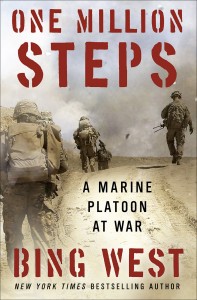 In late summer of 2010, Kennedy moved the 3rd Battalion, 7th Marine Regiment, or 3/7, up to Sangin. Due to return shortly to the States, 3/7 was tasked was to take over positions from the British and reconnoiter the district in preparation for the next Marine battalion.
In late summer of 2010, Kennedy moved the 3rd Battalion, 7th Marine Regiment, or 3/7, up to Sangin. Due to return shortly to the States, 3/7 was tasked was to take over positions from the British and reconnoiter the district in preparation for the next Marine battalion.
Max, a Pashtun interpreter who had served with coalition forces since 2005, summarized what 3/7 found.
“IEDs were everywhere,” Max told me. “The Marines had to fire rockets just to blow a safe path out of the market. The farmers turned their backs on us. I couldn’t figure out who was a Taliban, and I’m pretty good at doing that. Man, Sangin’s a crazy place.”
Crazy was an apt word. For four years, the Taliban had exported opium and imported explosives. The farmers profited and in turn supported the Taliban, who planted thousands of IEDs around the British outposts. When the Marines began clearing operations farther to the south, more Taliban fled north to Sangin. Eventually the British were isolated inside their forts, while on the other side of the minefields the Taliban were safe inside farming compounds.
 In early October of 2010, both the British troops and the 3/7 Marine battalion left. The 3rd Battalion, 5th Marine Regiment, or 3/5, moved in. Kennedy ordered 3/5 to seize control of the farmlands. There would be no “forward line of toops.” For the next six months, the Marines would patrol constantly. On average, a Marine would walk two and a half miles each day. Six thousand steps a day. One million steps.
In early October of 2010, both the British troops and the 3/7 Marine battalion left. The 3rd Battalion, 5th Marine Regiment, or 3/5, moved in. Kennedy ordered 3/5 to seize control of the farmlands. There would be no “forward line of toops.” For the next six months, the Marines would patrol constantly. On average, a Marine would walk two and a half miles each day. Six thousand steps a day. One million steps.
From the Book ONE MILLION STEPS by Bing West. Copyright © 2014 by Bing West. Reprinted by arrangement with Random House, an imprint of Random House, a division of Random House, Inc. All rights reserved.
 Soldier of Fortune Magazine The Journal of Professional Adventurers
Soldier of Fortune Magazine The Journal of Professional Adventurers


